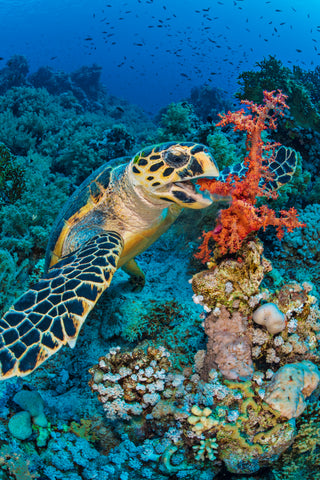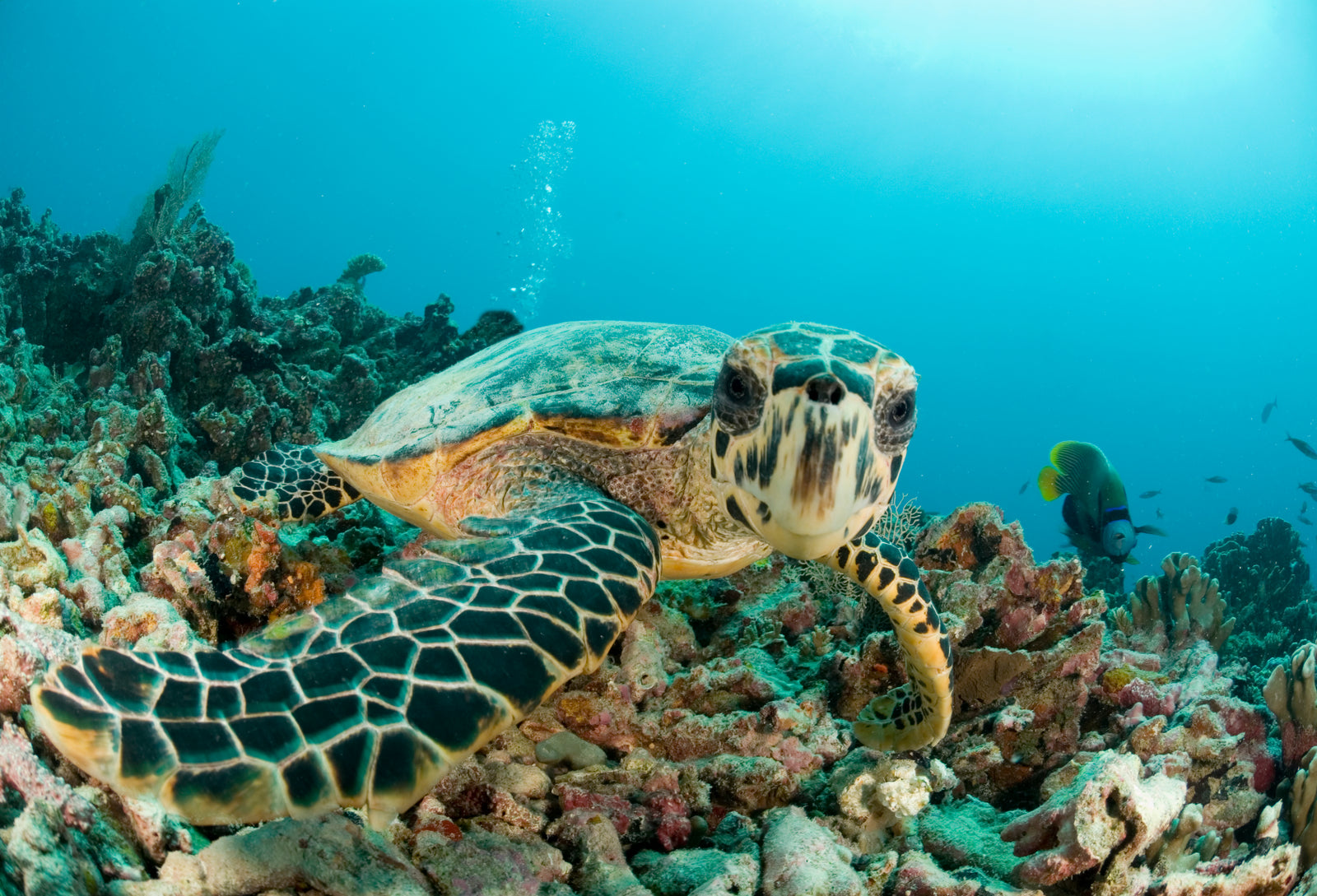Your Cart is Empty
Wow! What a stunning creature! The hawksbill turtle’s colourful shell and fancy patterns have made it world famous. But its beautiful looks are also one of the reasons why this amazing marine reptile has become a seriously endangered species.
 Hawksbill turtles live in tropical waters all over the planet, including parts of the Pacific. They can be found right across this vast ocean – from Southeast Asia and the east coast of Australia to the west coasts of America. Their strange name comes from the shape of their beak, which looks a bit like a bird of prey’s bill. But hawksbills are best known for their oval shell, or carapace. These turtles have been hunted for their attractive shells for hundreds of years. The hard shell material is known as tortoiseshell (which is a bit confusing!). It’s used to make jewellery and ornaments. Wildlife trade in tortoiseshell is now banned, but it still happens in some parts of the world.
Hawksbill turtles live in tropical waters all over the planet, including parts of the Pacific. They can be found right across this vast ocean – from Southeast Asia and the east coast of Australia to the west coasts of America. Their strange name comes from the shape of their beak, which looks a bit like a bird of prey’s bill. But hawksbills are best known for their oval shell, or carapace. These turtles have been hunted for their attractive shells for hundreds of years. The hard shell material is known as tortoiseshell (which is a bit confusing!). It’s used to make jewellery and ornaments. Wildlife trade in tortoiseshell is now banned, but it still happens in some parts of the world.
 Hawksbill turtles love to eat sea sponges. They use their pointed, bird-like beaks to pick these weird animals out of cracks and crevices on coral reefs. This stops the sponges covering the coral too much and helps keep the reef healthy. One turtle can eat half a ton of sponges in a year. That’s like you eating 10,000 slices of sponge cake!
Hawksbill turtles love to eat sea sponges. They use their pointed, bird-like beaks to pick these weird animals out of cracks and crevices on coral reefs. This stops the sponges covering the coral too much and helps keep the reef healthy. One turtle can eat half a ton of sponges in a year. That’s like you eating 10,000 slices of sponge cake!
Image Credit (left): Alex Mustard / naturepl.com
 A female hawksbill turtle lays her eggs on the same tropical beach that she was born on. She drags herself ashore at night, digs a pit in the sand with her flippers, and fills it with over 100 eggs. The mother-tobe then crawls straight back into the sea, so she never even gets to see her own babies! They hatch about 60 days later and immediately hurtle together towards the waves. The heart-shaped hatchlings are tiny – just 2.5cm long and weighing only around 15g (similar to a £2 coin). Aww, cute!
A female hawksbill turtle lays her eggs on the same tropical beach that she was born on. She drags herself ashore at night, digs a pit in the sand with her flippers, and fills it with over 100 eggs. The mother-tobe then crawls straight back into the sea, so she never even gets to see her own babies! They hatch about 60 days later and immediately hurtle together towards the waves. The heart-shaped hatchlings are tiny – just 2.5cm long and weighing only around 15g (similar to a £2 coin). Aww, cute!
The number of hawksbill turtles in the world has dropped by a huge amount over the last 150 years. No one really knows how many are left in the ocean. Hawksbills are now CRITICALLY ENDANGERED, which means the chance of them becoming extinct is extremely high. The biggest danger is still from illegal hunting for their shells, but these turtles also face other threats:

Image credit (above) Jordi Chias / naturepl.com
Climate change could have another effect on hawksbill turtles. Whether a baby turtle is born male or female depends on the temperature of the egg while it’s incubating. Global warming might mean that more females than males are born in the future. This could make it harder for hawksbills to breed.
The World Wide Fund for Nature (WWF) and other conservation organisations are helping hawksbill turtles by:

Good news! Some projects in the Pacific seem to be working. Scientists thought that hawksbills were extinct in the Eastern Pacific area until some were found nesting there in 2007. And the number of turtles in the Solomon Islands in the Western Pacific is thought to be going up, too! Hawksbill turtles play an important part in keeping marine habitats healthy – they aren’t just there to look pretty. But without them, our oceans certainly wouldn’t be as beautiful.
Comments will be approved before showing up.
Our Animal Besties writing contest from 'Nature's Best Buddies' issue brought in a flood of heartwarming, imaginative and often hilarious tales of unexpected friendships. From swans befriending capybaras to chickens bonding with foxes, your entries were full of surprise, kindness and creativity. A h...
January’s JAWsome Creatures competition brought some of the most imaginative and fearsome designs we've ever seen! From predators with sabre-like teeth to extraordinary beaks with unique feeding tricks, your entries were truly jaw-dropping. A huge thank you to everyone who took part – we loved seeing your wild and wonderful creations!
The Wildlife Photographer of the Year competition, produced by the Natural History Museum, never fails to amaze, and 2024 was no exception. Thousands of incredible images were submitted, but only a few made it to the People’s Choice Award.



